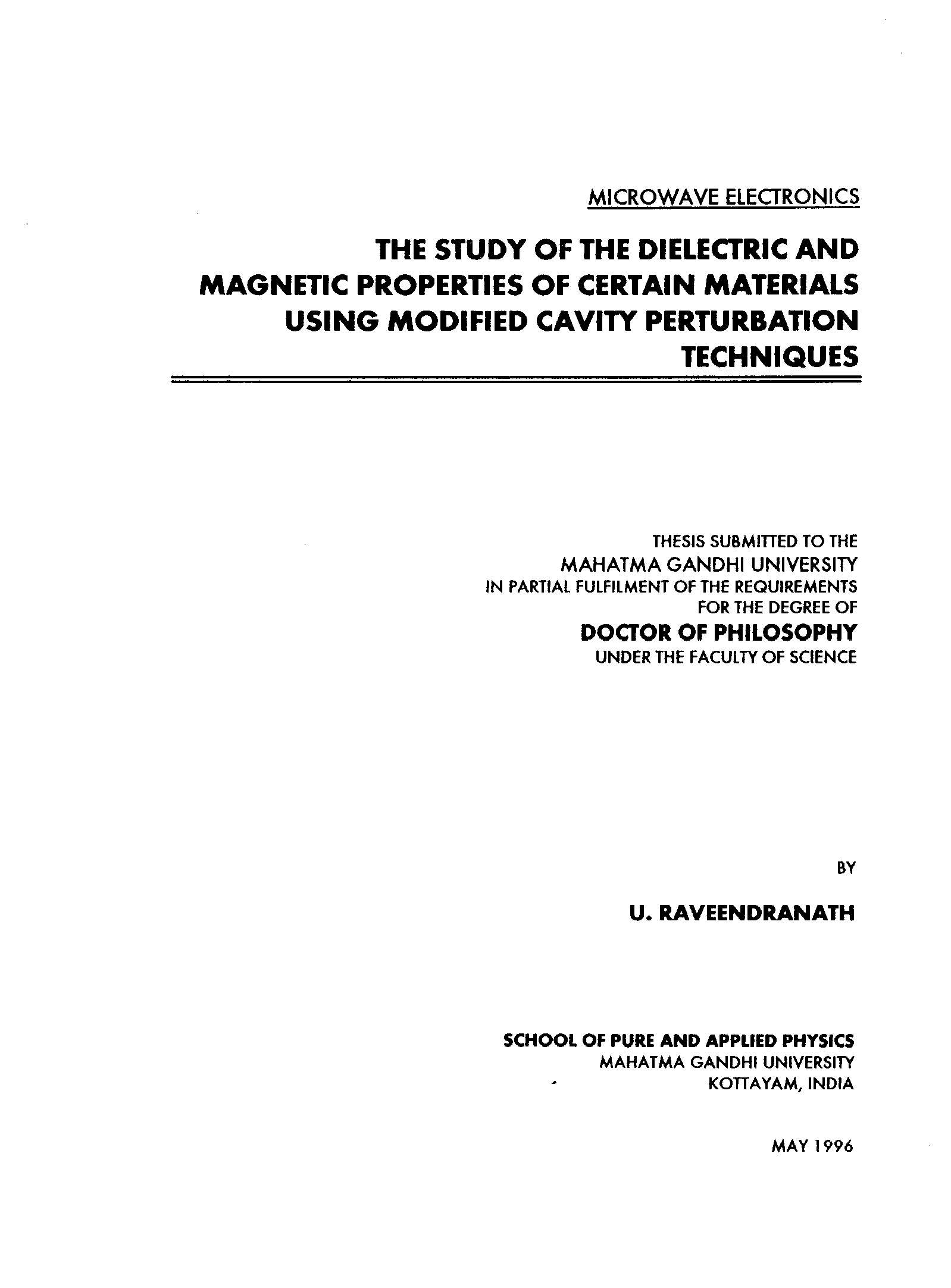| |||||||||||
- TITLE
- DEDICATION
- CERTIFICATE
- DECLARATION
- ACKNOWLEDGEMENT
- CONTENTS
- 1. INTRODUCTION
- 1.1 Frequency domain methods
- 1.1.1 Free space methods
- Fig.1.2 Free space experimental set-up for complex permittivity measurement
- 1.1.2 Transmission line methods
- Fig.1.3 Transmission line method
- 1.1.3 Automatic network analyzer methods
- Fig.1.4 Automatic network analyser method
- 1.1.4 Cavity perturbation techniques.
- Fig.1.5 (b) Cross-sectional view of cylindrical reflection type cavity resonator
- Fig.1.6 Re - entrant cavity.
- 1.1.5 Resonant cavity methods
- Fig.1.7 Length tuning resonant cavity methods
- Fig.1.8 Cross-sectional view of the cavity
- 1.2 Time domain methods
- Fig.1.9 Schematic representation of the experimental set-up for time domain transmission measurement method
- 1.3 Miscellaneous methods
- 1.4 Motivation of the present study
- 1.5 Brief sketch of present study
- 2. REVIEW OF THE PAST WORK
- 3. DESIGN AND FABRICATION OF CAVITY RESONATORS
- 3.1 Introduction
- 3.2 General aspects of design of rectangular waveguide cavities
- 3.3 Fabrication of rectangular waveguide cavity resonators
- Fig. 3.1 Amplitude response of the S band rectangular waveguide cavity
- Fig.3.2 Amplitude response of C-band rectangular waveguide cavity
- Fig.3.3 Amplitude response o f X-band rectangular waveguide cavity
- Table 3.2 Resonant frequencies and Q-values of S, C, and X band cavities.
- Fig.3.4 Cross-sectional view of the sample chamber
- 3.4 Design and fabrication of coaxial transmission line resonators
- Fig.3.5 Coaxial transmission line resonator
- Table 3.5 Characteristic features of coaxial resonators.
- 4. THEORY AND MEASUREMENTS
- 4.1 Introduction
- 4.2 Theoretical analysis for the determination of complex permittivity of materials using rectangular waveguide cavity
- Fig. 4.1 Sample positioned at the maximum electric field in the rectangular wave guide cavity
- 4.3 Theory for the determination of conductivity of the materials
- 4.4 Theory for the determination of complex permeability of materials using rectangular waveguide cavity
- Fig.4.2 Sample positioned at the maximum magnetic field in the rectangular waveguide cavity
- 4.5 Theory for the determination of complex permittivity of materials using coaxial cavity resonator
- Fig.4.3 Cross-sectional view of the coaxial transmission line resonator
- 4.6. Measurement of complex permittivity, complex permeability and conductivity of materials using rectangular waveguide cavities
- Fig.4.4 Block diagram of the experimental set-up
- Fig.4.5 Schematic diagram of the rectangular waveguide cavity resonator (side view)
- Fig.4.6 Amplitude response of the rectangular waveguide cavity. 4 (a) Unloaded cavity, (b) Cavity loaded with sample.
- Fig.4.7 Experimental set-up for the measurement of complex permeability
- Fig.4.8 Experimental set-up for the measurement of complex permittivity of vapours
- 4.7. Measurement of complex permittivity of materials using coaxial transmission line resonators
- 5. EXPERIMENTAL RESULTS
- 5.1 Introduction
- 5.2 Dielectric behaviour of certain high loss, medium loss and low loss liquids
- Fig. 5.1 Conductivity vs. Frequency for various liquids
- 5.3 Dielectric behaviour of polluted water
- 5.3.1 Effect of inorganic pollutants
- 5.3.2 Effect of organic pollutants
- 5.3.3 Study of the dielectric behaviour of polluted water collected fromvarlous sltes
- 5.4 Dielectric properties of vapours at microwave frequencies
- a) Dielectric properties of water vapour
- b) Dielectric properties of methanol vapour
- c) Dielectric behaviour of acetone vapour
- d) Dielectric behaviour of chloroform vapour
- 5.5 Conductivity and dielectric properties of certain conducting polymers
- Fig. 5.3. Structure of conducting polymers.
- a) Polyaniline
- b) Polyanisidine
- c) Copolymer of aniline and anisidine
- d) Copolymer of aniline and benzidine
- e) Copolymer of anisidiie and benzidine
- 5.6 Dielectric properties of natural rubber latex at microwave frequencies
- a) Dielectric behaviour of natural rubber latex (field latex)
- b) Dielectric properties of rubber latex with clay as a filler
- c) Dielectric properties of rubber latex with different types of fillers
- 5.7 Dielectric properties of certain biological liquids
- a) Dielectric behaviour of normal and diabetic human serum
- b) Dielectric behaviour of normal and diabetic human urine
- 5.8 Dielectric and magnetic properties of certain ferrite materials
- 6. CONCLUSION
- Scope for the future work
- APPENDICES
- APPENDIX A Design of irises for coupling microwave power to the cavities
- APPENDIX B A triple corner reflector antenna for enhanced gain and modified radiation pattern
- APPENDIX C Modified radiation patterns of an asymmetric hollow sectoral dielectric horn antenna
- APPENDIX D Synthesis and microwave characterisation of Ba1-X Srx (B1/23+ Nb15+) O3+ [B3+m Sm, Er, Gd] dielectric resonators.
- REFERENCES
- LIST OF PUBLICATIONS




 Full Screen
Full Screen


